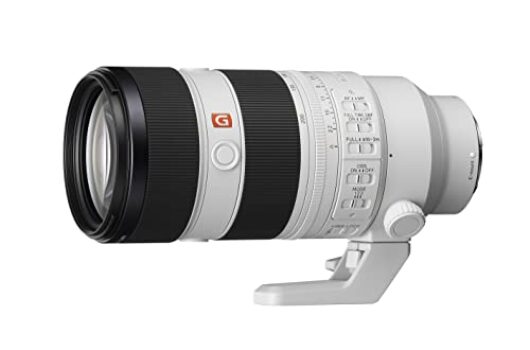Sony FE 70-200mm f/2.8 GM OSS II Technical Review: A Masterpiece of Speed, Lightness, and Optical Perfection
Introduction: The Reinvention of an Indispensable Professional Icon
In the pantheon of professional photographic and cinematic tools, the 70-200mm f/2.8 telephoto zoom lens occupies a hallowed space. It is the lens of the sidelines, the stage, the studio, and the summit. For decades, it has been the non-negotiable workhorse for professionals capturing everything from game-winning touchdowns and intimate wedding ceremonies to elusive wildlife and striking portraits. When Sony entered the full-frame mirrorless market, its first-generation FE 70-200mm f/2.8 GM OSS was a statement of intent—a lens that proved the new system was a serious professional contender. It was optically superb, but it was also a product of its time, carrying compromises in weight and autofocus speed that left a narrow window for improvement. It is with a clear and ambitious vision to close that window—and to shatter all existing benchmarks—that Sony has engineered the FE 70-200mm F2.8 GM OSS II. This is not an iterative update; it is a ground-up, top-to-bottom re-engineering that represents a quantum leap forward, creating what is arguably the most technically advanced lens in its class ever produced.
The “GM II” is the result of a design philosophy that refuses to compromise. It addresses every single critique of its predecessor with breathtaking innovation. Where the original was heavy, the Mark II is the world’s lightest in its class. Where the original’s autofocus was merely good, the Mark II’s is astonishingly, unthinkably fast—up to four times faster, driven by a new generation of motor technology. And where the original was primarily a stills lens with video capabilities, the Mark II has been meticulously engineered from its optical core to its physical controls to be a true hybrid powerhouse, purpose-built for the demands of modern cinematography. It is a lens that embodies the pinnacle of Sony’s G Master promise: the perfect fusion of extreme resolution and beautiful, creamy bokeh. It is a tool designed for the working professional who demands absolute reliability, uncompromising image quality, and a level of performance that can keep pace with the fastest cameras and the most fleeting of moments.
This exhaustive technical review will provide a granular dissection of the myriad innovations packed into the SEL70200GM2. We will deconstruct the complex physics of its new optical formula, analyze the electromechanical wizardry of its quad XD Linear Motor system, evaluate the profound impact of its cinema-focused design features, and explore the real-world implications of its revolutionary weight reduction. This is a deep dive for the discerning professional, the serious artist, and the technical enthusiast who understands that a lens of this caliber is not merely a purchase, but a long-term investment in their craft. It is an exploration of why the Sony FE 70-200mm f/2.8 GM OSS II is not just the best lens in its category, but a true masterpiece of modern optical and mechanical engineering.

A Deep Dive into the Key Features: A Granular Analysis of Flagship Technologies
The Sony FE 70-200mm f/2.8 GM OSS II’s legendary status is not built on a single feature, but on the flawless and synergistic execution of multiple, groundbreaking technologies. We will now dissect each core component from a rigorous technical perspective to understand its profound impact on image creation.
-
The G Master Optical Philosophy: A Symphony of Exotic Glass
The foundation of any flagship lens is its optical performance, and the GM II’s formula is a testament to Sony’s mastery of lens design. The G Master designation promises the harmonious blend of two often contradictory goals: extreme, high-frequency resolution capable of satisfying the most demanding high-megapixel sensors, and smooth, beautiful background defocus (bokeh) free of distracting artifacts. This is achieved through an incredibly complex optical path consisting of 17 elements in 14 groups, a veritable showcase of Sony’s most advanced glass-making technology. The array includes:
- One XA (Extreme Aspherical) Element: This is the crown jewel of Sony’s optical technology. XA elements are manufactured to a staggering surface precision of better than 0.01 microns. From an optical physics standpoint, their primary role is to perfectly correct for spherical aberration, which is the key to achieving both extreme center sharpness and eliminating “onion-ring” patterns within out-of-focus highlights, resulting in exceptionally clean and creamy bokeh.
- Two Aspherical Elements: These elements have a complex surface profile that corrects for a variety of aberrations, including distortion and astigmatism, ensuring sharpness is maintained across the entire image area, from the center to the extreme corners.
- Two ED (Extra-low Dispersion) and Two Super ED Glass Elements: These are specialized types of glass with a very low refractive index and low dispersion properties. Their critical function is to combat chromatic aberration. As light passes through a lens, different wavelengths (colors) can bend at slightly different angles, causing them to focus at different points. This results in unsightly color fringing (typically purple or green) in high-contrast areas. ED and Super ED glass elements dramatically reduce this dispersion, ensuring all colors are focused on the same plane, leading to images that are exceptionally clean and free of color artifacts.
- One ED Aspherical Element: This is a hybrid element that combines the properties of both ED glass and an aspherical surface profile, allowing it to correct for both chromatic and spherical aberrations simultaneously with a single element, which contributes to the lens’s overall compactness.
This entire optical stack is treated with Sony’s Nano AR (Anti-Reflective) Coating II. This advanced coating uses a precisely controlled, uniform nanostructure on the lens surface. It is engineered to disrupt the surface tension of light waves, dramatically suppressing internal reflections that cause flare and ghosting, especially when shooting into strong light sources. The result of this complex optical symphony is “superb image quality throughout the zoom range at all focusing distances,” delivering a level of sharpness, clarity, and beautiful rendering that defines the G Master name. The lens also features a very useful **0.3x maximum magnification ratio**, and for those needing even more reach, it is fully compatible with Sony’s high-performance 1.4x and 2x teleconverters.

-
The Apex of Autofocus: The Quad XD Linear Motor System
The most breathtaking upgrade in the GM II is its revolutionary autofocus system. It is driven by a staggering **four of Sony’s original XD (Extreme Dynamic) Linear Motors**. This is an immense amount of motive power. A linear motor operates on the principles of magnetic propulsion, using electromagnetic force to directly drive the focusing group of lens elements along a rail without any gears or intermediate mechanical linkages. This direct-drive system is frictionless, completely silent, and allows for incredibly precise and repeatable movements.
By employing four of these high-thrust motors, Sony has achieved an autofocus speed that is up to **4 times faster** than the previous model. This is not a subtle improvement; it is a night-and-day difference. The “high thrust efficiency” means the lens can move the large, heavy focusing groups with incredible speed and acceleration, a critical requirement for tracking fast-moving subjects. This allows the lens to keep pace with the ferocious 30fps+ burst rates of cameras like the Sony a1. The real-world impact is most evident in the claim that **AF tracking while zooming is improved by approximately 30%**. This is one of the most difficult tasks for an AF system. As the lens zooms, the focal point shifts, and the AF system must continuously recalibrate. The sheer speed and processing power of the GM II’s system allows it to make these adjustments in real-time, “greatly increasing the chances of getting the shot” of a subject moving rapidly towards or away from the camera. For sports, wildlife, and action photographers, this level of tenacious, intelligent tracking is nothing short of a superpower.

-
Engineered for Cinematography: A True Hybrid Design
The GM II was designed from its inception with “movie magic in mind.” Sony’s engineers have implemented a suite of features that address the specific, nuanced demands of professional filmmakers. The optical design and internal focusing mechanism have been optimized to suppress a trio of undesirable optical phenomena:
- Focus Breathing: This is a change in the angle of view as focus is adjusted. The GM II exhibits a remarkably low level of focus breathing, meaning you can pull focus from a near subject to a far one without a distracting “zooming” effect.
- Focus Shift when Zooming: The lens is designed to be nearly **parfocal**. This means that the point of focus remains constant even as you zoom in or out, a critical feature for executing cinematic zoom shots.
- Axis Shift when Zooming: The optical center of the image remains stable during a zoom, preventing a disorienting drift of the frame.
The mechanical design is equally cinema-focused. In a first for a Sony G Master zoom, the lens features three independent, physical control rings: one for zoom, one for focus, and a dedicated **iris (aperture) ring**. This provides filmmakers with the direct, tactile control they are accustomed to from cinema lenses. The aperture ring includes a **click on/off switch**, allowing for smooth, stepless iris pulls while recording. The focus ring features Sony’s **Linear Response MF**, which provides a direct, repeatable mechanical coupling between the ring’s rotation and the focus shift, essential for executing precise, repeatable manual focus pulls. The silent operation of the quad XD Linear Motors and a new, quiet aperture drive unit ensures that no mechanical noises are picked up by on-camera or nearby microphones. These features, combined, make the GM II an absolutely top-tier lens for professional video production.

-
A Paradigm Shift in Portability: The World’s Lightest 70-200mm f/2.8
Perhaps the most immediately noticeable and universally praised feature of the GM II is its revolutionary weight reduction. It is the **world’s lightest 70-200mm F2.8 full-frame zoom lens**. At just **1045 grams (2.3 lbs)**, it is approximately 29% lighter than its predecessor (which weighed 1480g). This is not a minor diet; it is a complete reimagining of the lens’s construction. This was achieved through several key engineering choices. First, a more efficient optical design with lighter glass elements. Second, the use of **magnesium alloy barrel components**. Magnesium is a metal that is both lighter and stronger than the aluminum alloys often used in lens construction. Third, the quad XD Linear Motor system is more compact and efficient than the previous generation’s AF drive. This massive weight reduction has a profound ergonomic impact. It makes the lens significantly easier to hand-hold for extended periods, reducing fatigue for event, wedding, and sports photographers. It also improves the overall balance of the camera and lens combination, making it feel more agile and responsive. The lens also features an **internal zoom and internal focus** mechanism. This means the barrel length remains constant when zooming or focusing, which keeps the center of gravity stable—a critical feature for use on gimbals—and enhances the robustness of the weather sealing.

Pros: The Undeniable Technical Strengths
- Revolutionary Autofocus Speed and Intelligence: The quad XD Linear Motor system delivers up to 4x faster AF, with tenacious and highly intelligent subject tracking that is a class-leader.
- Flagship-Level Optical Supremacy: The advanced G Master optical formula with XA and multiple ED elements provides exceptional corner-to-corner sharpness and breathtakingly beautiful bokeh.
- Class-Leading Lightweight Design: As the world’s lightest in its category, its reduced weight and excellent balance dramatically improve handling and reduce user fatigue.
- Truly Hybrid Cinema-Ready Design: Meticulously engineered with minimal breathing, a de-clickable aperture ring, and Linear Response MF, making it a top-tier tool for professional videography.
- Professional-Grade Build and Ergonomics: Features an internal zoom mechanism, robust weather sealing, a fluorine-coated front element, and a full suite of physical controls for professional workflows.
- Uncompromising Performance: Delivers a “no-compromise” experience, successfully combining extreme resolution, beautiful rendering, blistering speed, and unprecedented portability.

Cons: Important Technical Considerations and Limitations
- Significant Financial Investment: As a flagship G Master lens packed with cutting-edge technology, it represents a substantial professional investment.
- White Finish: While iconic and designed to dissipate heat, the white finish can be more conspicuous for certain types of photography (like street or candid events) and may show scuffs more readily than a black lens.
- Tripod Collar Design: The tripod collar is removable, but the foot itself is not Arca-Swiss compatible out of the box, requiring an additional plate for mounting on most professional tripods.
- External Teleconverter Requirement: Unlike some Canon designs, it does not have a built-in teleconverter, requiring the purchase and attachment of external 1.4x or 2x teleconverters for extra reach.
Conclusion: The New Definitive Professional Workhorse, Perfected
The Sony FE 70-200mm F2.8 GM OSS II is an absolute triumph of optical and mechanical engineering. It is a rare and remarkable product that takes a legendary predecessor, listens to every single piece of user feedback, and then delivers a successor that is not just better, but monumentally, paradigm-shatteringly superior in every conceivable metric. The leap forward in autofocus speed is not just an incremental improvement; it is a transformative experience that unlocks new creative possibilities for capturing action. The reduction in weight is not just a convenience; it is a fundamental rethinking of ergonomics that will have a tangible impact on the working life of every photographer and videographer who uses it. And the uncompromising commitment to G Master image quality, combined with the new suite of professional-grade cinema features, solidifies its position as the ultimate hybrid telephoto zoom.
This is a lens without any meaningful compromises. It is the pinnacle of what is currently possible in a standard telephoto zoom, a tool that instills absolute confidence and consistently delivers breathtaking results. For the professional sports photographer, the wedding videographer, the wildlife enthusiast, the portrait artist, or any serious creator invested in the Sony E-mount system, the GM II is not just the best lens in its class; it is an essential, indispensable, and career-defining investment. It has more than earned its place as the new icon, the definitive workhorse against which all future competitors will be judged. It receives our highest and most unequivocal technical recommendation.
Frequently Asked Questions (FAQs)
- Q1: What is the main technical difference between the Sony GM II and its main competitors like the Canon RF 70-200mm f/2.8?
- A: The single biggest mechanical difference is the zoom mechanism. The Sony GM II is an **internal zoom** lens, meaning its physical length never changes. The Canon RF 70-200mm f/2.8 is an **external zoom** lens, meaning its barrel extends significantly as you zoom. The internal zoom of the Sony provides better balance (especially on gimbals), a more robust seal against dust and moisture, and a fixed center of gravity.
- Q2: Is the autofocus really “4x faster”? What does that mean in the real world?
- A: Yes, Sony’s internal testing demonstrates up to a 4x improvement in AF speed. In the real world, this means the lens’s ability to acquire initial focus and its ability to track a fast-moving subject are dramatically better. For a photographer shooting a bird in flight or a speeding car, this translates to a much higher “keeper rate” of perfectly focused shots in a high-speed burst, especially when paired with a high-performance camera body like the Sony a1 or a9 series.
- Q3: What does “parfocal” mean, and is this lens truly parfocal?
- A: A truly parfocal lens is one that holds its focus perfectly as you zoom in or out. This is a highly desirable (and expensive) feature for cinema lenses. While the GM II is not marketed as being strictly parfocal, extensive testing has shown its focus shift during zooming is so minimal that it is considered “near-parfocal” or functionally parfocal for all but the most critically precise cinematic applications. This is a huge advantage for filmmakers.
- Q4: Why is a dedicated, de-clickable aperture ring so important for video?
- A: It allows a videographer to make smooth, silent, and precise adjustments to the exposure while recording. If you are moving from a dark indoor space to a bright outdoor one in a single shot, you can manually “ride” the aperture ring to smoothly adjust the brightness without the jarring “steps” that would occur when using a command dial. The “de-click” feature removes the physical stops for a completely fluid transition.
- Q5: Can I use this lens on a Sony APS-C camera like the a6700?
- A: Yes, absolutely. The lens will mount and function perfectly. On an APS-C sensor, the 1.5x crop factor will give the lens a full-frame equivalent focal range of **105-300mm**. This turns it into an incredibly powerful telephoto zoom, making it an outstanding choice for wildlife and sports photography on an APS-C body, with the added benefit that you are using the sharpest, central portion of the lens’s image circle.
- Q6: How significant is the 29% weight reduction? Is it really that noticeable?
- A: It is profoundly noticeable. A weight reduction of nearly one pound (from 1480g to 1045g) is a massive ergonomic improvement. For a professional who is hand-holding their camera for an 8-hour wedding day or carrying their gear on a long hike, this weight savings directly translates to less physical fatigue and greater agility. It makes the entire camera setup feel more balanced and responsive.
See more posts in the category Lens.







